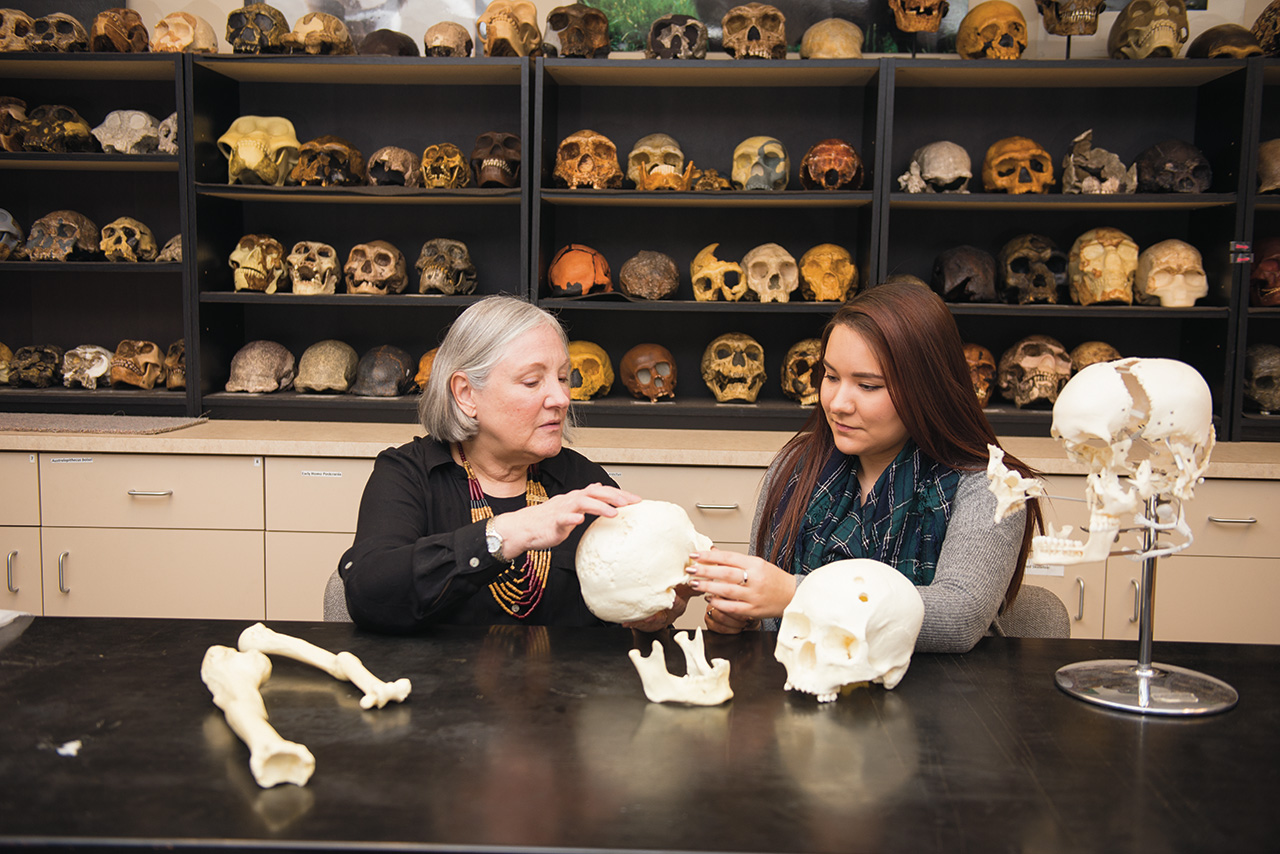In the 1970s, the skeletal remains of about 120 Native Americans were retrieved from an ancient mound complex on a bluff overlooking the Mississippi River valley in Western Illinois. They had been discovered accidentally during a home construction project.
Anthropologists date the site, now known as Schroeder Mounds, to the Late Woodland period, around 900 to 1150 A.D. Forty years after the find, it’s still unclear who these pre-Columbian people were, what their quality of life was, which cultural group they belonged to, and whether they grew corn or were pre-maize horticulturists.
Anthropology Professor Maria Smith and her undergraduate students in Illinois State’s Department of Sociology and Anthropology are now searching for answers to those mysteries. Illinois State has had a temporary loan of the burial collection since 2009, and Smith began incorporating the problem-solving into her Human Paleopathology and Skeletal Analysis course in 2010. Since then several of her students have published articles on what they have discovered in journals such as the International Journal of Osteoarchaeology, the International Journal of Paleopathology, and Field Notes.
Appears In“Every time you access the collection,” Smith said, “there are unanswered questions that could potentially be answered. And that’s what I think intrigues the students.”
Katharine Woollen, a senior anthropology major, is one of the latest of Smith’s students to turn an initial examination of the skeletons into a potentially publishable research project. For her Independent Study in Anthropology, Woollen is investigating the ankle and foot trauma she found, surprisingly, in 10 percent of the adults. The vast majority of the trauma cases were seen in males.
“Every time you access the collection, there are unanswered questions that could potentially be answered. And that’s what I think intrigues the students.”—Maria Smith
She first noticed the trauma while taking Smith’s paleopathology course in fall 2015. Woollen had laid out the skeleton of an adult male on a lab table and saw that his tarsal and metatarsal (foot) bones were badly broken and deformed.
The location of the injuries posed a question about what the adults were doing that resulted in them breaking their metatarsals instead of their ankle bones. “Did they drop something on their foot?” Woollen said. “Would they have regularly been doing something to more likely cause that kind of fracture to happen?”
Her discovery raises a lot more questions about the Schroeder Mounds people’s culture and labor activities than it provides answers, Woollen said. “Everything goes through your head: Was this a male activity pattern? Was it unique to Schroeder Mounds? Or was it typical of other peoples who lived in the same economic context?”
A primary problem in investigating the Schroeder Mounds collection is the lack of archaeological context—there is virtually no material culture information upon which to reconstruct lifeways, Smith said. “We have to be sleuths and ask ourselves, What would be the health correlates of a hunter-gather society? What would be the correlates of an agricultural society? We look for the suite of pathologies that are known to be associated with these strategies and assess Schroeder against it.”
Skeletal analysis has generated controversy in recent years. Under the federal Native American Graves Protection and Repatriation Act (NAGPRA), Native American remains and cultural items can be returned to lineal descendants and culturally affiliated tribes. The law was originally enacted to, among other things, prevent the looting of graves, Smith said. “Unaffiliated prehistoric material like this—that is, we have no idea who they are—can now be claimed by any Native group who can insist upon reburial even without the benefit of analysis,” Smith said. “I have to keep in mind, this is not just about reconstructing prehistory, this is about someone’s personal ancestry.”
Smith’s students have begun piecing together evidence showing the Schroeder Mounds people were sedentary and, based on an examination of their teeth, that corn was indeed a staple of their diet. The latter observation has broader significance. The widespread growing of corn, along with the related explosion in population and large village settlement, is associated with a later peoples known as the Mississippians (circa 1000–1400 A.D.). Their culture flourished in lower Central Illinois and centered at Cahokia, near what is now St. Louis.
“Once you get high-yield maize, something called flint corn, then agriculture takes off,” Smith said. The Mississippian period also co-associates with a new cosmology, perhaps a new shift in the religion, Smith added. The unanswered question is, What was the cultural and economic impact of Cahokia at faraway upriver sites like Schroeder Mounds?
Last fall, Woollen finished her Schroeder skeletal analysis and was collecting information about foot and ankle trauma from other pre-Columbian Illinois sites. She submitted her research for publication in the journal Field Notes in January.
“Katharine’s project is a link in a bigger chain that hopefully over the next several years will give us a pretty good overview of what’s going on during the time period when Cahokia was socio-politically rising,” Smith said. “What is important to underscore, as well, is that these investigators are undergraduates, and how many opportunities do undergraduates have to do primary research? This particular research matters because, as I remind them, with the repatriation issue, they might be the last eyes to see it.”
Woollen is set to graduate in May. She plans to attend graduate school and study forensic anthropology. “I’m just so thrilled that Dr. Smith agreed to do this project with me. I’ve learned so much from, and about, the Schroeder Mounds people. I can’t wait to see what else can be learned from them.”
Kevin Bersett can be reached at kdberse@IllinoisState.edu.


I hope that repatriation comes much sooner than later. Respect for the 1st People of this land has not often been forthcoming.